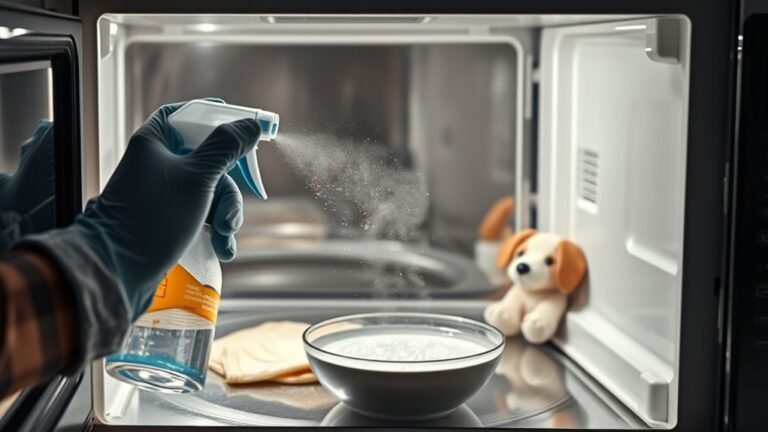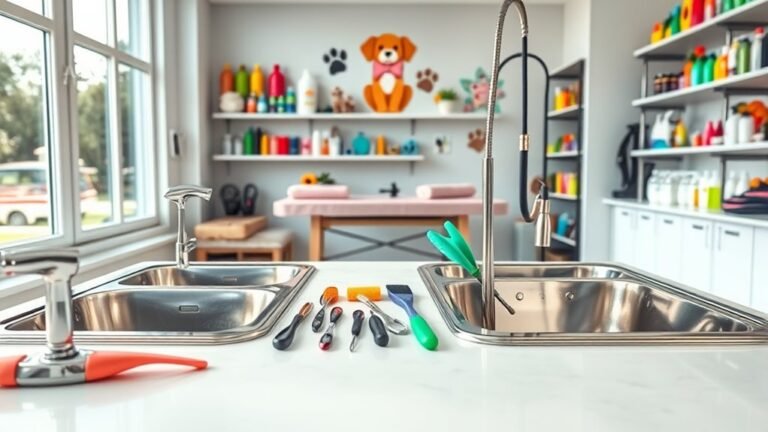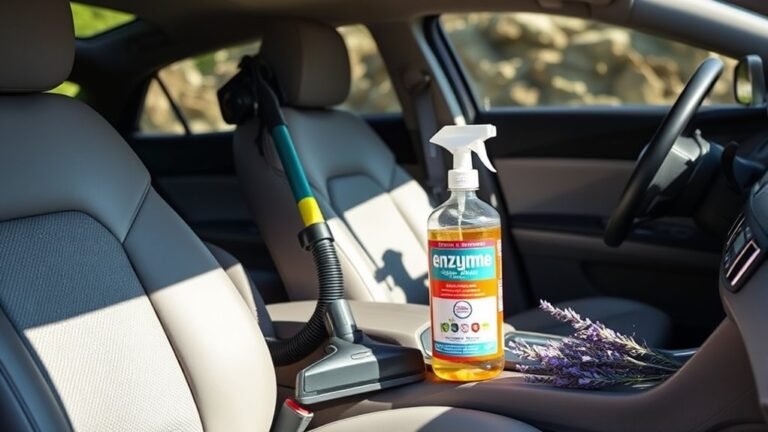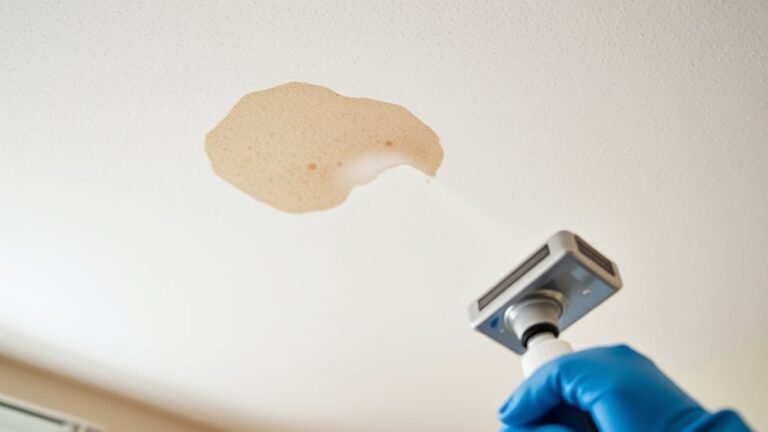Best Way to Sanitize Your Pet Mess
When you deal with pet messes, act fast by blotting urine or spills without rubbing to avoid stains. Use enzymatic cleaners that break down odors and stains naturally, then follow with baking soda or vinegar solutions to deodorize and sanitize. For different surfaces like carpet or hardwood, pick cleaners that won’t damage finishes. Combining these steps helps keep your home fresh and safe. Stick around to discover easy, natural methods and smart ways to prevent future messes.
Identifying Common Pet Messes That Require Sanitizing

Pet messes can vary widely, but knowing which ones need proper sanitizing is key to keeping your home healthy. When you spot common pet accidents like urine spots, vomit, or feces, you need to act fast. These messes aren’t just unsightly—they can harbor bacteria and odors that linger if not cleaned thoroughly. Proper mess identification helps you prioritize where to focus your efforts. For example, a simple water spill doesn’t require the same attention as a urine stain, which can cause odor and health issues if ignored. By quickly recognizing these typical pet messes, you can maintain a fresh, safe environment that lets you and your pets enjoy freedom without worry or discomfort.
Choosing the Right Cleaning Products for Pet Stains
Although many cleaning products claim to tackle stains, not all are safe or effective for the specific challenges pet messes present. When choosing cleaning product types, you want ones designed specifically for pet stains, like enzymatic pet stain removers. These break down proteins and odors that typical cleaners can’t handle, preventing your pet from returning to the same spot. Avoid harsh chemicals that might irritate your furry friend or damage surfaces. Look for non-toxic, eco-friendly options that clean thoroughly without leaving harmful residues. By selecting the right pet stain removers, you’ll maintain a fresh, sanitary space and keep your pets safe. Taking control of your cleaning choices guarantees freedom from stubborn stains and lingering smells, making your home a happier place for everyone.
Step-by-Step Guide to Cleaning and Sanitizing Pet Urine
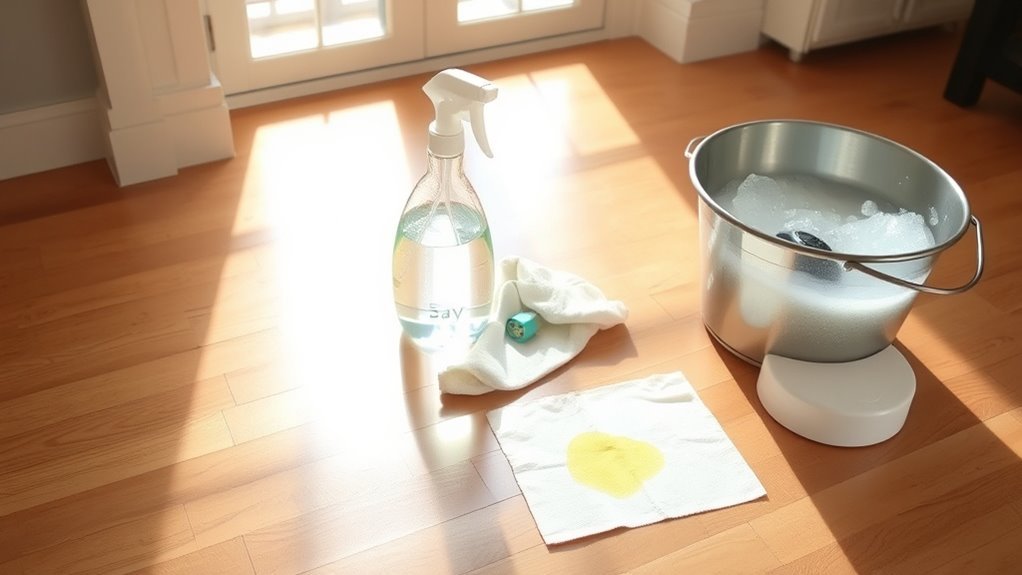
When you spot pet urine, acting quickly is key to preventing stains and odors. You’ll want to use the right cleaning solutions that effectively break down the mess without damaging surfaces. Finally, applying odor removal techniques guarantees your home stays fresh and odor-free.
Immediate Cleanup Steps
Since urine can quickly soak into surfaces and cause lingering odors, you’ll want to act fast to clean it up thoroughly. Your immediate response is key to effective pet cleanup. First, grab some paper towels or a clean cloth to blot up as much urine as possible—don’t rub, or you may spread the mess. Next, gently press down to absorb the liquid, replacing towels as needed. Once you’ve removed the excess moisture, keep the area ventilated to help it dry faster and prevent odors from settling in. Acting swiftly not only saves you time later but also keeps your space fresh and free from stubborn stains. Taking these immediate cleanup steps gives you the freedom to enjoy your home without lingering pet mess worries.
Effective Cleaning Solutions
A few reliable cleaning solutions can make all the difference in removing pet urine stains and odors effectively. Start with a mixture of white vinegar and water—it’s a powerful, natural cleaning hack that breaks down urine compounds and prevents stains from setting. After blotting the area dry, sprinkle baking soda to absorb moisture and neutralize any lingering acids. Follow up with a gentle enzyme-based cleaner designed specifically for pet messes to guarantee deep stain prevention and thorough sanitization. Avoid harsh chemicals that might restrict your freedom with toxic residues or damage surfaces. By using these simple, effective cleaning hacks, you keep your space fresh and stain-free without the hassle. This approach lets you handle accidents confidently, maintaining a clean home while enjoying the freedom of pet ownership.
Odor Removal Techniques
To tackle pet urine odors effectively, you’ll want to break down the process into clear, manageable steps. Start with odor absorption techniques like sprinkling baking soda or activated charcoal directly on the affected area. These natural absorbers trap and neutralize odors, freeing your space from lingering smells. After letting it sit, vacuum thoroughly. Next, consider scent masking methods only after neutralizing the odor—using essential oils or pet-safe sprays can help freshen the air without just hiding the smell. Remember, masking odors without proper absorption only delays the problem. Focus on removing the source first, then add scent masking for a clean, inviting environment. By following these steps, you’ll reclaim your freedom from unwanted pet odors and enjoy a fresher home.
Effective Methods for Removing Pet Odors
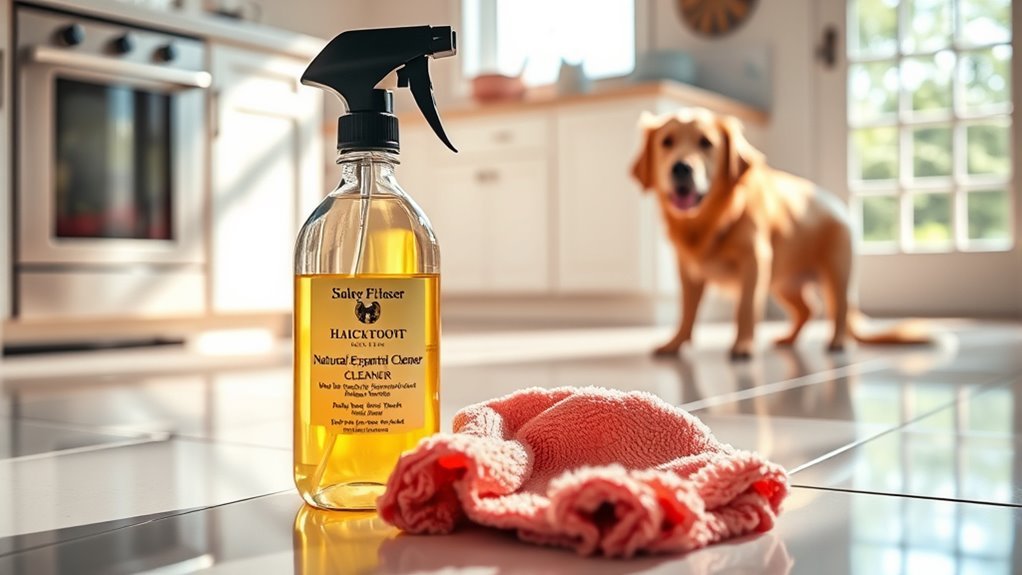
When it comes to tackling pet odors, you’ll want to choose the right cleaning agents. Natural odor eliminators can neutralize smells without harsh chemicals, while enzyme-based cleaners break down odor-causing proteins at the source. Using these methods together can help keep your home smelling fresh and clean.
Natural Odor Eliminators
Although commercial cleaners can be effective, you might prefer natural odor eliminators to tackle pet smells without harsh chemicals. Citrus sprays are a fantastic, fresh-smelling option that naturally neutralizes odors while leaving your space smelling clean and vibrant. You can easily make your own by mixing citrus peels with water, giving you control over what goes into your home. Vinegar solutions are another powerful choice; they cut through odors and disinfect surfaces without any toxic residue. Simply dilute white vinegar with water for an affordable, eco-friendly spray that works wonders on pet messes. By using these natural methods, you maintain your freedom from synthetic chemicals while keeping your home fresh and welcoming, making cleaning both effective and safe for your furry friends.
Enzyme-Based Cleaners
Since pet odors can be stubborn and persistent, enzyme-based cleaners offer a highly effective solution. You’ll appreciate how these cleaners harness the unique enzyme properties to break down organic messes at their source, rather than just masking smells. This means the cleaner effectiveness goes beyond surface-level freshness, tackling odors embedded deep in carpets, fabrics, or floors. When you use enzyme-based cleaners, you empower yourself to maintain a clean, odor-free space without harsh chemicals, giving you the freedom to live comfortably with your pets. Just apply the cleaner, let the enzymes work, and watch as they naturally digest stains and odors, restoring your home’s freshness. For lasting results, choose products specifically designed to target pet messes and enjoy a truly clean environment.
Sanitizing Different Surfaces: Carpet, Hardwood, and Tile
Dealing with pet messes means you’ll need different approaches depending on the surface you’re cleaning. For carpet cleaning, act quickly—blot the area, then apply a pet-safe enzymatic cleaner to break down stains and odors. Avoid soaking the carpet to prevent mold growth. When it comes to hardwood maintenance, use a gentle cleaner that won’t strip the finish. Wipe up messes immediately to protect the wood and prevent warping. For tile floors, a mixture of warm water and mild detergent works well, followed by disinfecting to kill bacteria. Tiles are forgiving, but grout can trap odors, so consider a grout cleaner or brush. Tailoring your sanitizing method keeps your home fresh and lets you enjoy the freedom of a clean, pet-friendly space.
Natural and DIY Solutions for Pet Mess Sanitization
Now that you know how to handle pet messes on various surfaces, you might want to explore natural and DIY solutions that are both effective and safe for your home and pets. Homemade sprays using simple ingredients like vinegar, baking soda, and water can sanitize without harsh chemicals. Adding essential oils such as lavender or tea tree not only boosts cleaning power but also leaves a fresh scent. These oils have natural antibacterial properties, making your DIY sprays even more efficient. You’re in control—customize your mixtures based on your pet’s needs and sensitivities. This approach keeps your space clean, reduces exposure to toxins, and saves money. Embracing natural solutions means you don’t have to sacrifice safety or effectiveness when sanitizing after your furry friend’s messes.
Preventative Measures to Minimize Future Pet Messes
Although accidents happen, taking preventative measures can greatly reduce the chances of future pet messes in your home. You can embrace freedom by combining preventative training with smart pet proofing home strategies. Teaching your pet boundaries and routines helps keep messes at bay. Meanwhile, pet proofing your space—like securing trash cans and using washable fabrics—creates a mess-resistant environment.
| Preventative Training | Pet Proofing Home | Benefits |
|---|---|---|
| Consistent routines | Secure trash cans | Less unexpected messes |
| Positive reinforcement | Washable furniture | Easier cleanup |
| Designated potty areas | Remove hazardous items | Safer, cleaner home |
Frequently Asked Questions
Can Sanitizing Pet Messes Affect My Pet’S Health?
You might wonder if sanitizing pet messes could impact your pet health. It can, especially if you use harsh cleaning products that leave toxic residues. You don’t want to restrict your pet’s freedom by exposing them to chemicals that could cause irritation or illness. Instead, choose pet-safe, non-toxic cleaners to keep your space clean without risking their well-being. That way, you maintain a safe environment where your pet can roam freely.
How Often Should I Sanitize My Pet’S Bedding?
You might wonder if you really need to clean your pet’s bedding often. Truth is, the cleaning frequency depends on bedding materials and your pet’s habits. For washable fabrics, aim for weekly washes to keep odors and germs at bay. If your pet sheds a lot or has allergies, more frequent cleaning helps maintain a fresh, healthy space. Regular care lets you enjoy freedom from mess and worry, keeping your furry friend comfy.
Are There Specific Sanitizers Safe for Puppies and Kittens?
You’ll want to choose puppy safe cleaners and kitten friendly disinfectants that are non-toxic and free from harsh chemicals. Look for products labeled specifically for pets or those with natural ingredients like vinegar or enzyme-based formulas. Avoid bleach or ammonia, as they can irritate sensitive paws and noses. Always rinse surfaces well and let them dry before your little ones explore. This way, you keep their space clean without compromising their freedom to roam safely.
Can Sanitizing Products Cause Allergies in Pets?
Yes, sanitizing products can cause allergies in pets, especially if they have pet sensitivities. You might notice allergy symptoms like itching, redness, or sneezing after using certain cleaners. To keep your furry friends safe, choose pet-friendly, fragrance-free products and always test a small area first. Being mindful lets you clean effectively without compromising your pet’s comfort or freedom to roam and enjoy their space happily.
How to Dispose of Pet Waste Safely After Cleaning?
When disposing of pet waste, you’ll want to use biodegradable bags to keep things eco-friendly and hassle-free. After cleaning, seal the waste tightly to prevent odors and bacteria from spreading. If you’re into composting options, make sure your pet waste is handled separately since it can contain harmful pathogens. This way, you’re caring for your space and the planet while keeping your freedom to enjoy the outdoors worry-free.

